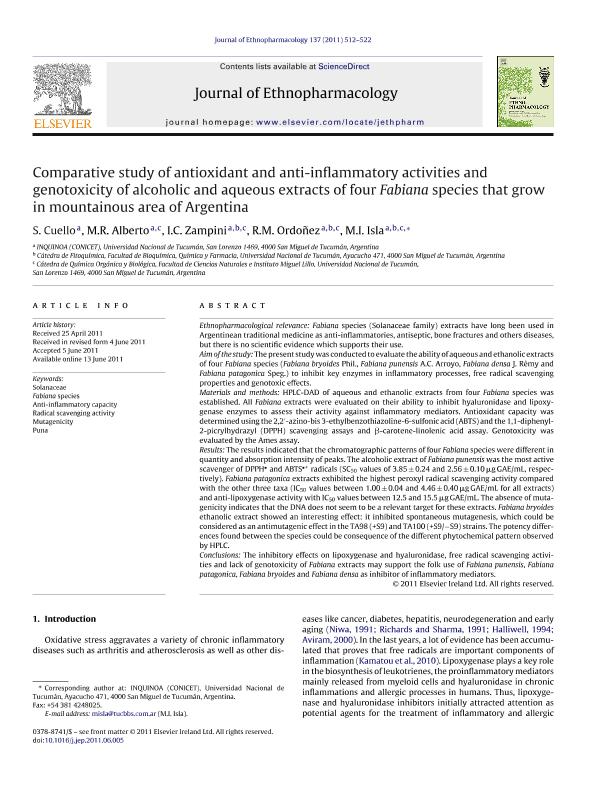Artículo
Comparative study of antioxidant and anti-inflammatory activities and genotoxicity of alcoholic and aqueous extracts of four Fabiana species that grow in mountainous area of Argentina
Cuello, Ana Soledad ; Alberto, Maria Rosa
; Alberto, Maria Rosa ; Zampini, Iris Catiana
; Zampini, Iris Catiana ; Ordóñez, Roxana Mabel
; Ordóñez, Roxana Mabel ; Isla, Maria Ines
; Isla, Maria Ines
 ; Alberto, Maria Rosa
; Alberto, Maria Rosa ; Zampini, Iris Catiana
; Zampini, Iris Catiana ; Ordóñez, Roxana Mabel
; Ordóñez, Roxana Mabel ; Isla, Maria Ines
; Isla, Maria Ines
Fecha de publicación:
09/2011
Editorial:
Elsevier Ireland
Revista:
Journal of Ethnopharmacology
ISSN:
0378-8741
Idioma:
Inglés
Tipo de recurso:
Artículo publicado
Clasificación temática:
Resumen
Ethnopharmacological relevance: Fabiana species (Solanaceae family) extracts have long been used in Argentinean traditional medicine as anti-inflammatories, antiseptic, bone fractures and others diseases, but there is no scientific evidence which supports their use. Aim of the study: The present study was conducted to evaluate the ability of aqueous and ethanolic extracts of four Fabiana species (Fabiana bryoides Phil., Fabiana punensis A.C. Arroyo, Fabiana densa J. Rmy and Fabiana patagonica Speg.) to inhibit key enzymes in inflammatory processes, free radical scavenging properties and genotoxic effects. Materials and methods: HPLC-DAD of aqueous and ethanolic extracts from four Fabiana species was established. All Fabiana extracts were evaluated on their ability to inhibit hyaluronidase and lipoxygenase enzymes to assess their activity against inflammatory mediators. Antioxidant capacity was determined using the 2,2′-azino-bis 3-ethylbenzothiazoline-6-sulfonic acid (ABTS) and the 1,1-diphenyl-2-picrylhydrazyl (DPPH) scavenging assays and β-carotene-linolenic acid assay. Genotoxicity was evaluated by the Ames assay. Results: The results indicated that the chromatographic patterns of four Fabiana species were different in quantity and absorption intensity of peaks. The alcoholic extract of Fabiana punensis was the most active scavenger of DPPH and ABTS + radicals (SC 50 values of 3.85 ± 0.24 and 2.56 ± 0.10 μg GAE/mL, respectively). Fabiana patagonica extracts exhibited the highest peroxyl radical scavenging activity compared with the other three taxa (IC 50 values between 1.00 ± 0.04 and 4.46 ± 0.40 μg GAE/mL for all extracts) and anti-lipoxygenase activity with IC 50 values between 12.5 and 15.5 μg GAE/mL. The absence of mutagenicity indicates that the DNA does not seem to be a relevant target for these extracts. Fabiana bryoides ethanolic extract showed an interesting effect: it inhibited spontaneous mutagenesis, which could be considered as an antimutagenic effect in the TA98 (+S9) and TA100 (+S9/-S9) strains. The potency differences found between the species could be consequence of the different phytochemical pattern observed by HPLC. Conclusions: The inhibitory effects on lipoxygenase and hyaluronidase, free radical scavenging activities and lack of genotoxicity of Fabiana extracts may support the folk use of Fabiana punensis, Fabiana patagonica, Fabiana bryoides and Fabiana densa as inhibitor of inflammatory mediators.
Archivos asociados
Licencia
Identificadores
Colecciones
Articulos(INQUINOA)
Articulos de INST.DE QUIMICA DEL NOROESTE
Articulos de INST.DE QUIMICA DEL NOROESTE
Citación
Cuello, Ana Soledad; Alberto, Maria Rosa; Zampini, Iris Catiana; Ordóñez, Roxana Mabel; Isla, Maria Ines; Comparative study of antioxidant and anti-inflammatory activities and genotoxicity of alcoholic and aqueous extracts of four Fabiana species that grow in mountainous area of Argentina; Elsevier Ireland; Journal of Ethnopharmacology; 137; 1; 9-2011; 512-522
Compartir
Altmétricas



